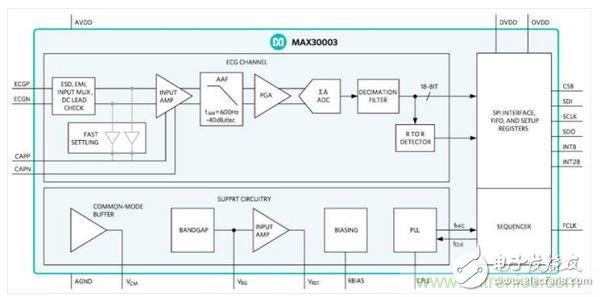Every day we hear that the Internet of Things and billions of MEMS and sensors will be added to our environment, but don't forget that if there is no proper signal conditioning for the MEMS/sensor interface, we will only send it to the processor. Unusable data that does not reflect user-related results.
A good data acquisition system (DAS) requires a wide dynamic range and very low distortion, as well as proper ADC interface input signal conditioning.
Every day we hear that the Internet of Things and billions of MEMS and sensors will be added to our environment, but don't forget that if there is no proper signal conditioning for the MEMS/sensor interface, we will only send it to the processor. Unusable data that does not reflect user-related results.
First, circuit designers need to have good tools. An excellent solution launched in 2016 is Maxim's wearable device integrated health sensor platform MAXREFDES100#. Designers must get the design to market quickly. This solution takes into account the myriad of ICs that need to be integrated into the complete MEMS and sensor conditioning front end. The solution also features linearization and calibration circuitry such as a programmable gain amplifier (PGA) to meet the needs of tuning a complete set of sensors. In 2017 we are expected to see more of these types of complete designer solution tools.
Automotive ADAS solutions are emerging in 2016, and automotive-related sensors require specific forms of sensor conditioning, especially when it comes to autonomous vehicles. Although we will not see fully autonomous vehicles in the next few years, the automotive electronics industry is gradually increasing its ADAS solution every year. In 2017 we will see more of these solutions.
A good data acquisition system (DAS) requires a wide dynamic range and very low distortion, as well as proper ADC interface input signal conditioning. An article on designing ultra-low distortion data acquisition systems - "How to design a -130-dB ultra-low distorTIon data-acquisiTIon system" for circuit designers Excellent technical guidance. Analog device suppliers will provide improved solutions for this area in 2017.
Resistance Temperature Detector (RTD) scale measurement data is designed through a dedicated analog front end (AFE) design (as designed in the article "Analog front-end design consider a TIons for RTD raTIometric measurements"). Accurately obtained. So what about the unique "One-wire interface over power pin for sensor signal conditioner" proposed by Texas Instruments? This communication interface for signal conditioning design can save one line using the Single Wire Interface (OWI) compared to traditional two-wire interfaces. From a cost and performance perspective, to make the IoT truly practical, we need to create more unique solutions, and we should see a lot in 2017.
A good data acquisition system (DAS) requires a wide dynamic range and very low distortion, as well as proper ADC interface input signal conditioning.
Every day we hear that the Internet of Things and billions of MEMS and sensors will be added to our environment, but don't forget that if there is no proper signal conditioning for the MEMS/sensor interface, we will only send it to the processor. Unusable data that does not reflect user-related results.
First, circuit designers need to have good tools. An excellent solution launched in 2016 is Maxim's wearable device integrated health sensor platform MAXREFDES100#. Designers must get the design to market quickly. This solution takes into account the myriad of ICs that need to be integrated into the complete MEMS and sensor conditioning front end. The solution also features linearization and calibration circuitry such as a programmable gain amplifier (PGA) to meet the needs of tuning a complete set of sensors. In 2017 we are expected to see more of these types of complete designer solution tools.

Automotive ADAS solutions are emerging in 2016, and automotive-related sensors require specific forms of sensor conditioning, especially when it comes to autonomous vehicles. Although we will not see fully autonomous vehicles in the next few years, the automotive electronics industry is gradually increasing its ADAS solution every year. In 2017 we will see more of these solutions.
A good data acquisition system (DAS) requires a wide dynamic range and very low distortion, as well as proper ADC interface input signal conditioning. An article on designing ultra-low distortion data acquisition systems - "How to design a -130-dB ultra-low distorTIon data-acquisiTIon system" for circuit designers Excellent technical guidance. Analog device suppliers will provide improved solutions for this area in 2017.
Resistance Temperature Detector (RTD) scale measurement data is designed through a dedicated analog front end (AFE) design (as designed in the article "Analog front-end design consider a TIons for RTD raTIometric measurements"). Accurately obtained. So what about the unique "One-wire interface over power pin for sensor signal conditioner" proposed by Texas Instruments? This communication interface for signal conditioning design can save one line using the Single Wire Interface (OWI) compared to traditional two-wire interfaces. From a cost and performance perspective, to make the IoT truly practical, we need to create more unique solutions, and we should see a lot in 2017.
Xlpe Control Cable,Termite Resistant Control Cable,Termite Proof Control Cable,Termite Proof Xlpe Control Cable
Baosheng Science&Technology Innovation Co.,Ltd , https://www.cablebaosheng.com